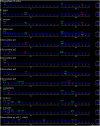Repetitive DNA Sequences and Evolution of ZZ/ZW Sex Chromosomes in Characidium (Teleostei: Characiformes)
- PMID: 26372604
- PMCID: PMC4570811
- DOI: 10.1371/journal.pone.0137231
Repetitive DNA Sequences and Evolution of ZZ/ZW Sex Chromosomes in Characidium (Teleostei: Characiformes)
Abstract
Characidium constitutes an interesting model for cytogenetic studies, since a large degree of karyotype variation has been detected in this group, like the presence/absence of sex and supernumerary chromosomes and variable distribution of repetitive sequences in different species/populations. In this study, we performed a comparative cytogenetic analysis in 13 Characidium species collected at different South American river basins in order to investigate the karyotype diversification in this group. Chromosome analyses involved the karyotype characterization, cytogenetic mapping of repetitive DNA sequences and cross-species chromosome painting using a W-specific probe obtained in a previous study from Characidium gomesi. Our results evidenced a conserved diploid chromosome number of 2n = 50, and almost all the species exhibited homeologous ZZ/ZW sex chromosomes in different stages of differentiation, except C. cf. zebra, C. tenue, C. xavante and C. stigmosum. Notably, some ZZ/ZW sex chromosomes showed 5S and/or 18S rDNA clusters, while no U2 snDNA sites could be detected in the sex chromosomes, being restricted to a single chromosome pair in almost all the analyzed species. In addition, the species Characidium sp. aff. C. vidali showed B chromosomes with an inter-individual variation of 1 to 4 supernumerary chromosomes per cell. Notably, these B chromosomes share sequences with the W-specific probe, providing insights about their origin. Results presented here further confirm the extensive karyotype diversity within Characidium in contrast with a conserved diploid chromosome number. Such chromosome differences seem to constitute a significant reproductive barrier, since several sympatric Characidium species had been described during the last few years and no interespecific hybrids were found.
Conflict of interest statement
Figures




Similar articles
-
The karyotypes and evolution of ZZ/ZW sex chromosomes in the genus Characidium (Characiformes, Crenuchidae).Comp Cytogenet. 2018 Oct 2;12(3):421-438. doi: 10.3897/CompCytogen.v12i3.28736. eCollection 2018. Comp Cytogenet. 2018. PMID: 30310546 Free PMC article. Review.
-
Chromosomal Mapping of Repetitive DNAs in Characidium (Teleostei, Characiformes): Genomic Organization and Diversification of ZW Sex Chromosomes.Cytogenet Genome Res. 2015;146(2):136-143. doi: 10.1159/000437165. Epub 2015 Jul 31. Cytogenet Genome Res. 2015. PMID: 26277929
-
Satellite DNA content of B chromosomes in the characid fish Characidium gomesi supports their origin from sex chromosomes.Mol Genet Genomics. 2020 Jan;295(1):195-207. doi: 10.1007/s00438-019-01615-2. Epub 2019 Oct 17. Mol Genet Genomics. 2020. PMID: 31624915
-
Evolution and conservation of Characidium sex chromosomes.Heredity (Edinb). 2017 Oct;119(4):237-244. doi: 10.1038/hdy.2017.43. Epub 2017 Jul 26. Heredity (Edinb). 2017. PMID: 28745717 Free PMC article.
-
Origin, Behaviour, and Transmission of B Chromosome with Special Reference to Plantago lagopus.Genes (Basel). 2019 Feb 18;10(2):152. doi: 10.3390/genes10020152. Genes (Basel). 2019. PMID: 30781667 Free PMC article. Review.
Cited by
-
Chromosomal Diversification in Pseudacanthicus Species (Loricariidae, Hypostominae) Revealed by Comparative Mapping of Repetitive Sequences.Animals (Basel). 2022 Sep 29;12(19):2612. doi: 10.3390/ani12192612. Animals (Basel). 2022. PMID: 36230353 Free PMC article.
-
The karyotypes and evolution of ZZ/ZW sex chromosomes in the genus Characidium (Characiformes, Crenuchidae).Comp Cytogenet. 2018 Oct 2;12(3):421-438. doi: 10.3897/CompCytogen.v12i3.28736. eCollection 2018. Comp Cytogenet. 2018. PMID: 30310546 Free PMC article. Review.
-
Against the mainstream: exceptional evolutionary stability of ZW sex chromosomes across the fish families Triportheidae and Gasteropelecidae (Teleostei: Characiformes).Chromosome Res. 2021 Dec;29(3-4):391-416. doi: 10.1007/s10577-021-09674-1. Epub 2021 Oct 25. Chromosome Res. 2021. PMID: 34694531
-
Telomere organization and the interstitial telomeric sites involvement in insects and vertebrates chromosome evolution.Genet Mol Biol. 2022 Nov 14;45(3 Suppl 1):e20220071. doi: 10.1590/1678-4685-GMB-2022-0071. eCollection 2022. Genet Mol Biol. 2022. PMID: 36394537 Free PMC article.
-
Multiple sex chromosomes in teleost fishes from a cytogenetic perspective: state of the art and future challenges.Philos Trans R Soc Lond B Biol Sci. 2021 Sep 13;376(1833):20200098. doi: 10.1098/rstb.2020.0098. Epub 2021 Jul 26. Philos Trans R Soc Lond B Biol Sci. 2021. PMID: 34304595 Free PMC article. Review.
References
-
- Buckup P. Family Crenichidae (South America daters) In: Reis RE Kullander SO Ferraris C, editor. Ckeck List of the Freshwater Fishes of South and Central America. Porto Alegre; 2003. pp. 87–95.
-
- Eschmeyer W. Species by family/Subfamily [Internet]. p. Available: http://researcharchive.calacademy.org/research/ich.
-
- Miyazawa CS, Galetti PM. First cytogenetical studies in Characidium species (Pisces: Characiformes, Characidiinae). Cytologia. 1994; 59: 73–79. Available: 10.1508/cytologia.59.73 - DOI
-
- Buckup PA. The monophyly of the Characidiinae, a Neotropical group of characiform fishes (Teleostei: Ostariophysi). Zool J Linn Soc. 1993; 108: 225–245. 10.1111/j.1096-3642.1993.tb00297.x - DOI
-
- Zanata AM, Camelier P. A new species of Characidium (Characiformes: Crenuchidae) from small coastal drainages in northeastern Brazil, with remarks on the pseudotympanum of some species of the genus. Neotrop Ichthyol. 2014; 12: 333–342. 10.1590/1982-0224-20130168 - DOI
Publication types
MeSH terms
LinkOut - more resources
Full Text Sources
Other Literature Sources

